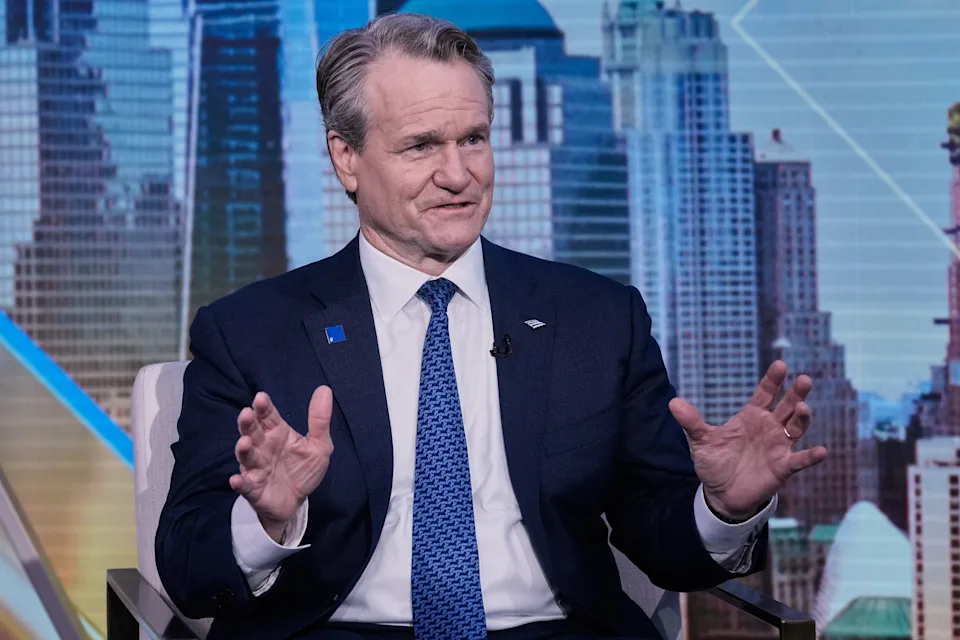Bank of America (BAC) CEO Brian Moynihan and his top lieutenants aren’t happy with how investors value the nation’s second-largest bank compared to rivals. They’re setting out to change that later this week.
The push to boost the bank’s fortunes officially kicks off Wednesday, when investors gather in downtown Boston to hear Moynihan and his team outline the firm’s ambitions.
It’s the Charlotte, N.C.-based lender’s first investor day in nearly 15 years, which underlines just how important — and uncharacteristic — the occasion is, said Scott Siefers, an analyst covering Bank of America for Piper Sandler.
“Management wants to give really everyone involved a chance to do a deep dive into the company, and hopefully from their perspective, see that there’s an opportunity in there for Bank of America’s stock to correct upward,” said Siefers, who has a neutral rating on BofA.
The event will also give investors a fresh look at the three senior executives recently elevated at BofA: co-presidents Dean Athanasia, age 59, and Jim DeMare, 56, who jointly oversee all of the bank’s core divisions, along with 57-year-old executive vice president and CFO Alastair Borthwick.
They are now seen as the leading contenders to one day succeed Moynihan, and until then, help boost his legacy.
‘We’re not entirely satisfied’
Big bank stocks traded to record highs in September and remain near these levels even as credit quality across Wall Street has grown as an issue. But Bank of America’s stock has still lagged that of its rivals. Shares are up 22% so far in 2025.
More importantly, over a five-year stretch, BofA’s stock trades 17 percentage points below its next closest peer, Citigroup (C), while Citi’s stock has climbed 44% in 2025.
“We’re not entirely satisfied as a management team with where we stand right now on relative value,” CFO Borthwick told investors at a September Barclays conference.
Table stakes for this week’s event will be BofA putting a profitability target on its growth ambitions, along with unspooling how the major bank plans to get there.
The nation’s three other largest banks, JPMorgan Chase (JPM), Wells Fargo (WFC), and Citigroup, have already rolled out some version of this, using a core profitability measurement known as return on tangible common equity (ROTCE).
JPMorgan, which has posted a 21% ROTCE through the first three quarters of this year, has set a 17% return target through the full business cycle. Citigroup is aiming for 10% to 11% returns by sometime next year as part of its broader transformation effort. Last month, Wells Fargo announced its pursuit of a 17% to 18% return over the next few years.
“Returns are not commensurate with the strength of their franchise, and so they need to put forth a better case on why that’s going to change,” Mike Mayo, a Wells Fargo analyst covering Bank of America, told Yahoo Finance.
So far this year, Bank of America has reported a roughly 14% ROTCE, according to Mayo. Analysts anticipate it will raise that return target somewhere within the range of 16% to 18%.
‘May have leaned in too far to the responsible part’
Bank of America has $3.4 trillion in assets today and boasts more than 70 million Main Street customers. It consistently ranks as one of the top four global Wall Street investment banks by fees, with enough scale for a $13 billion technology budget for 2025, $4 billion of which is set aside for developing new initiatives such as artificial intelligence.
But it stood on far less solid ground when 66-year-old Moynihan first became CEO in 2010.
Back then, Bank of America was still digesting two sizable financial crisis acquisitions — troubled subprime mortgage lender Countrywide Financial and hobbled investment bank Merrill Lynch — and in the midst of racking up tens of billions of dollars in legal bills tied to its mortgage division. It was no surprise that after a massive restructuring of the bank during that period, Moynihan introduced “responsible growth,” a mantra that has served as the bank’s guiding principle ever since.
In more recent years, BofA’s growth has been viewed by some as too risk-averse. The bank “may have leaned in too far to the responsible part” of the strategy, Wells Fargo’s Mayo said. “Responsible growth was the correct strategy after the financial crisis, but I’d say this decade investors want them to lean in more on the growth part, without going too far.”
What has also put more pressure on Moynihan and the bank was a decision during the COVID-19 pandemic in 2020 and 2021 to plow hundreds of billions of dollars of excess deposits into longer-dated mortgage-backed securities.
Once the Federal Reserve raised interest rates, the outcome meant lower interest income than peers who waited, such as its closest rival, JPMorgan, which took the opposing approach and thereby caught a bigger boost from higher rates.
Now there is something of a reversal afoot. Bank of America is in the midst of rolling off approximately $10 billion worth of those underwater securities and replacing them with higher-yielding assets. Piper Sandler’s Siefers calls it a “baked-in profitability improvement.”

